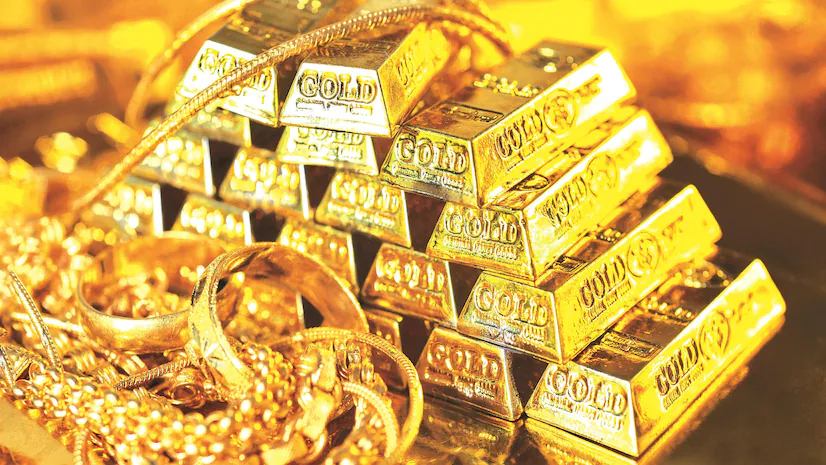Gold faces $2,500 resistance UBS sees more allocation ahead
The market will gradually adapt to gold prices above $2,500 per ounce.
August 23rd saw spot gold prices bearish below the $2,500 mark, currently trading near $2,485.67 per ounce. Yesterday, influenced by the cautious stance of Federal Reserve officials, gold prices fell by more than 1%, losing the $2,500 threshold, closing at $2,484.57 per ounce.
On the first day of the Jackson Hole conference, three officials each made statements to the media, namely Susan Collins, the President of the Federal Reserve Bank of Boston, Jeffrey Schmid, the President of the Federal Reserve Bank of Kansas City, and Patrick Harker, the President of the Federal Reserve Bank of Philadelphia. In line with Powell's "cautious doves" approach, all three officials refused to provide a clear path for interest rate cuts and emphasized the importance of continuing to observe data.
Affected by the speeches, the US dollar index began to rebound from a 13-month low, rising by 0.38% at the end of trading on Thursday, reporting 101.50. The index touched its lowest since December 28 at 100.92 on Wednesday; US Treasury yields rebounded on Thursday from a two-week low set the previous trading day, in line with the trend in the European bond market. Before Powell's speech, investors were reluctant to make hasty moves.
Futures trader Blue Line Futures stated, "We have seen the two-year yield rise, the US dollar index rise... The performance of gold over the past three trading days has been incredible. It has set a historical high, so traders will naturally take profits in this trend."
Despite gold's weakness after reaching $2,500 per ounce, UBS said in its latest research report that as the Federal Reserve's expectation of loose monetary policy, the decline in real interest rates, and the weakening of the US dollar, the market will gradually adapt to gold prices above $2,500 per ounce.
In addition, the ongoing geopolitical risks, as well as the upcoming US elections and their potential impact on fiscal policy, have also increased investors' interest in gold.
UBS stated that although the net long positions in the New York Commodity Exchange (COMEX) have increased recently, the level is still below the historical peak, indicating that the overall market pricing is still relatively light, and investors still have ample space to continue increasing their gold allocation. UBS expects that as the Federal Reserve begins to cut interest rates, the cost of holding gold will decrease, and the inflow of funds into gold ETFs will further increase.
In terms of official demand, the global central banks' "gold rush" is still ongoing.
According to UBS tracking data, India's gold reserves increased by 5 tons in July, while China's gold reserves remained unchanged for the third consecutive month. UBS believes that although the pace of central banks buying gold has slowed down in recent months, they will still be net buyers of gold. The gold holdings of many emerging market central banks are still relatively low compared to total reserve assets, indicating that these central banks still have room to increase their gold holdings.
As for physical gold, UBS observed that with the continuous rise in gold prices, the demand for physical gold does indeed face certain pressures. According to UBS statistical data, in July, the total gold imports of China and India fell by 58% year-on-year, although due to the strong performance at the beginning of the year, the total imports from the beginning of the year to now have still increased by 5%.
Regarding the recent weak demand for physical gold, UBS reassures the market not to worry too much. As the seasonal demand approaches, the physical demand in China and India is expected to pick up. In India, the wedding and festival season is coming, which is usually a key period for gold consumption, and the lower import tax and robust economic prospects indicate an increase in gold demand.
As for the future trend of gold prices, Bank of China stated that from a technical level, on the daily chart, gold prices closed with a doji candlestick pattern, leaving a long lower shadow line below, showing the market's strong support strength. Although the current gold price is still hovering near the MA5 moving average and slightly below the MA10 moving average, the overall trend still maintains a bullish momentum.
On the 4-hour chart, yesterday's morning rebound did not last, but the subsequent three consecutive falling lines formed a standard correction pattern. With the release of the evening employment correction data, the gold price rebounded again and returned to the package of the previous large positive line, showing a high-level consolidation and ready to go posture.
The market should also be alert to the risk of gold falling due to Powell's unexpected hawkish stance in his speech on Friday. The current support positions are $2,500, $2,484, and $2,445, respectively.

·Original
Disclaimer: The views in this article are from the original Creator and do not represent the views or position of Hawk Insight. The content of the article is for reference, communication and learning only, and does not constitute investment advice. If it involves copyright issues, please contact us for deletion.